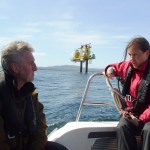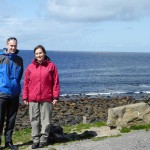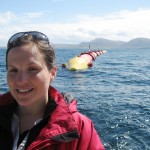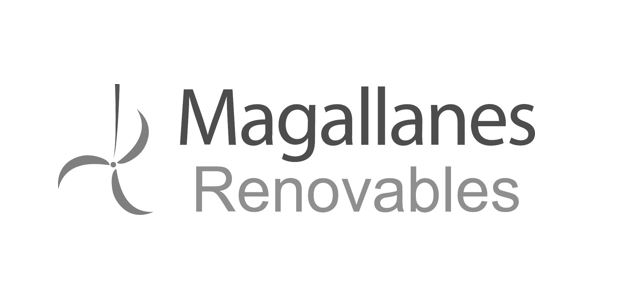Guest blog: Dee Nunn (RUK) reflects on marine energy visit to Orkney
Dee Nunn, Wave and Tidal Development Manager for RenewableUK, reflects on her recent visit to see Orkney’s marine renewables sector in action:
When John Griffiths, Technical Director of EMEC, invited me up to the test centre I jumped at the opportunity to see wave and tidal devices up close and to learn directly from the many people working hard to develop the sector in Orkney. The prominence of marine energy is evident even before you land. Arriving on a beautifully clear day into Kirkwall Airport, I was excited to glimpse two thin red and yellow lines floating off the mainland – Pelamis wave generators! There are even display boards about marine energy devices in the middle of the baggage carousel at the airport.
In 2001 the House of Commons Select Committee on Science and Technology recognised the need for a real sea test facility in order for the UK to maintain its lead in wave and tidal energy. Their recommendation led to the construction of EMEC. It was a bold step for the UK government to take, as Eileen Linklater, Client Relationship and Marketing Manager at EMEC, explained to me during my visit, there were no contracts with developers in place when the investment was made. But the “If you build it they will come” approach has paid off. In fact, EMEC has now expanded the number of berths it can offer and is self-sufficient, funded through berth leases and other services. I was thrilled to be visiting at the peak of deployment with ten of the fourteen berths in use.
I was met at Kirkwall Marina by Jenny Norris, Research Director at EMEC for our boat trip out to the Fall of Warness tidal test site. Jenny was kind enough to answer my many questions about the site, devices and research programme. I hadn’t realised that at more than 4m/s the tidal flows are so strong here that it is impossible to mark the location of tidal turbines using marker buoys as they would be pulled underwater. The immense power in the water was visible both in the raised water behind the legs of the OpenHydro platform and the force in the engine of our boat required to stay in one place. OpenHydro do not plan on using their platform for commercial installations but for the demonstration site it allows turbines to be easily lifted in and out of the water to run tests and modify the devices. We were fantastically lucky to be at the site at the perfect time to witness the turbine being lifted, still spinning, from the water.
The creation of EMEC has provided more than a place to test devices. The centre is a driver for research, standardisation and certification of devices, all essential processes in creating an industry. In addition, the cluster of device developers, vessel operators, environmental surveyors and researchers which has built up around the centre, provides an environment which enables collaboration and facilitates progress. As I travelled around the islands I saw many renewables related businesses, backing up EMEC’s estimate that there are now over 300 people employed directly in the wave and tidal sector in Orkney, a significant proportion of the 20,000 population.
During my visit I was able to meet people from several local companies including James Murray, Business Development Manager for Scotrenewables developers of a floating tidal device, and Gareth Davies, Managing Director of Aquatera who provide environmental services and products. Both are Orkney based and passionate about the importance of the islands and marine energy to each other. Shipping and fishing were big industries here historically and Orcadians have a deep respect for the power of the sea and for protecting the marine environment.
Both James and Gareth are concerned about what will happen to the centre of excellence which has been built up in Orkney, and the socio-economic benefits this brings with it, if the grid connection to the mainland is not upgraded soon. In 2013, the equivalent of 103% of the electricity used in Orkney was generated on the islands from renewable sources, however this would have been more if there had not been the inadequacies in the grid. Despite increasing capacity through active network management, the link is at breaking point and without a new cable to the mainland, development of array scale marine renewable energy in Orkney looks impossible, putting at risk the thriving marine energy community that has built up here.
On the second day of my trip I was able to visit the wave test site at Billia Croo. On the way to see the substation, Lisa MacKenzie, Marketing and Communications Officer, let me drive EMEC’s own electric car. Neil Kermode, Managing Director of EMEC explained to me how they are looking for interim solutions to the grid capacity issue. Increasing the number of electric vehicles on the island is one option. Fuel is expensive here and the distance you can travel without getting on a ferry is limited, so cars wouldn’t need a huge range. By charging vehicles at times when excess renewable energy is being produced some of this energy could be stored and used usefully.
On reaching Aquamarine Power’s onshore generation unit in Billia Croo I was struck by the similarity of the turbine and generator to those I had seen in the fossil fuel industry. Aquamarine’s approach is to use the power of the waves to pump high pressure water ashore and use it to drive adapted hydroelectric turbines to generate power. It reminded me that there is a lot to be learnt from established industries.
Heading out on a boat from Stromness with Rob and Deborah from Pelamis to see their two P2 devices (one owned by Scottish Power Renewables) and the Wello Penguin up close, we were joined by journalists from Germany, emphasising that EMEC is renowned across the world. It was a beautiful day with hardly a ripple in the sea, not the best day to see wave generators in action. Even so, Deborah told me the P2s were generating 15kW. Seeing the devices up close I was able to understand how they operate and to appreciate the scale of them, the P2s are 180m long and 4m in diameter. However, I found the visual impact to be much lower than I would expect for devices of this size – with a vast sea and the hills of Hoy as a backdrop it is easy to perceive them as much smaller.
On leaving Orkney I’ve gained an insight into the issues the sector is dealing with from environmental monitoring demands to insufficient grid capacity. I am enthused by the energy and commitment of the people I met there and driven to help them overcome the barriers they are facing. The ambition of the UK and Scottish governments in funding EMEC back in 2003 was a huge contribution to the success of the sector and the leading position in the UK today. Perhaps a similar level of foresight and ambition is now needed to establish a grid connection that will allow the sector to capitalise on its current success and grow in Orkney.
I thoroughly enjoyed my trip to EMEC. Thanks to everyone who took the time to share their wealth of experience with me during my visit and I hope it won’t be too long before I get to come back!








